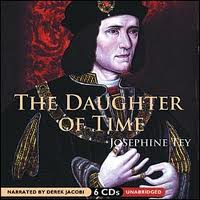Richard III and The Daughter of Time
 Today’s headlines trumpeting the remarkable discovery of Richard III’s remains gives me an excuse to trumpet something else – Josephine Tey’s mystery novel about Richard III, The Daughter of Time, rated as the best mystery novel of all time by the British Crime Writer’s Association. (The Mystery Writers of America rate it as number 4, but it should be noted that two of the works ahead of Tey’s are collections, not individual novels.)
Today’s headlines trumpeting the remarkable discovery of Richard III’s remains gives me an excuse to trumpet something else – Josephine Tey’s mystery novel about Richard III, The Daughter of Time, rated as the best mystery novel of all time by the British Crime Writer’s Association. (The Mystery Writers of America rate it as number 4, but it should be noted that two of the works ahead of Tey’s are collections, not individual novels.)
Richard III is best known as Shakespeare’s villainous, humpback, withered-arm king who murdered his own nephews (and a bunch of other people) to accede to the throne. This portrait of Richard III, the last of the Plantagenets, made him one of the most hated men of history and stems back to rumors and reports following his brief reign (1483-85) and his death in battle with Henry VII, the first Tudor king. But there have always been inconsistencies in the story, not to mention missing evidence and suspicious beginnings, which have led many to doubt whether this portrayal of Richard wasn’t the product of pro-Tudor propaganda from those who supported the Tudors or else feared them. The truth about Richard III and his two young nephews (the “Princes in the Tower”) is one of the greatest mysteries of the last half-millennium. It is the mystery that Tey’s character, Scotland Yard Detective Alan Grant, takes up as he is laid up in the hospital.
What’s more gripping than a great mystery? A mystery that’s 500 years old and shrouded in mystery. Bon appetit!


















